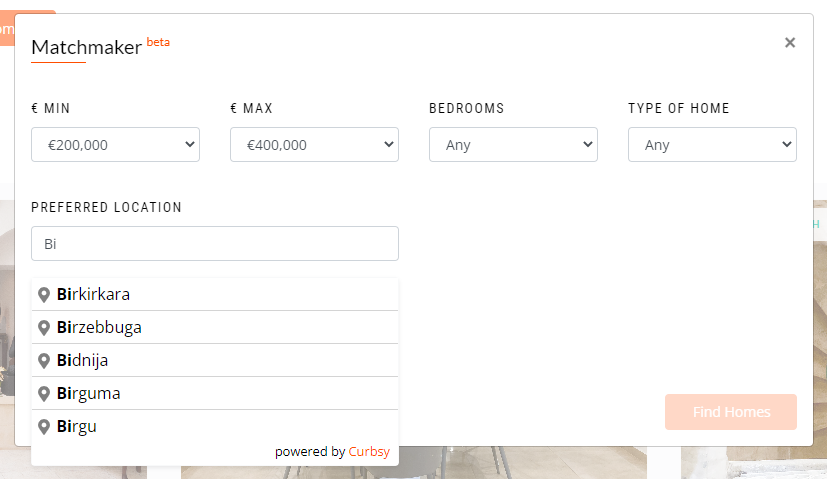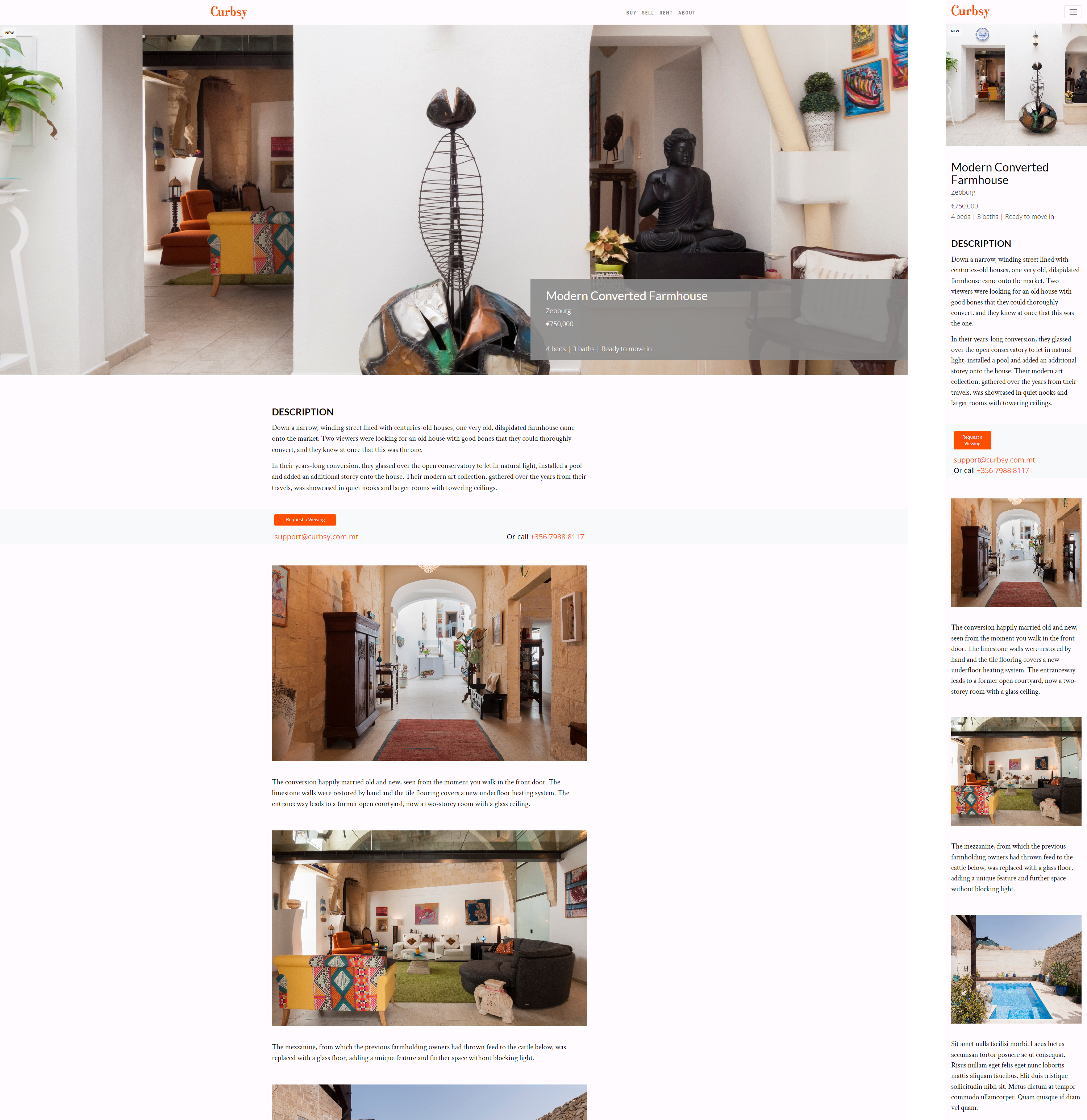Creating a magazine-inspired website and property management portal

- Solutions Magazine-inspired website, custom search engine and back-end property management portal
- Technologies C#, .NET, Entity Framework, Axios, SQL Server, Javascript, CSS3, HTML5, ElasticSearch, Azure
- Country Malta
Introduction
Curbsy Malta Ltd was founded in 2019 by one of the Curbsy (IOM) Ltd owners and a Maltese real estate agent with decades of experience. They set out to disrupt the Maltese real estate market by offering a more open and honest buying and selling process and a new way to match prospective buyers with their ideal home using search results based on relevance scoring rather than traditional filtering.
Project Description
The founders of Curbsy believed that traditional real estate processes over-valued the importance of estate agents and under-valued the emotional connection developed between the prospective buyer and the house they chose to buy. They also felt that traditional real estate websites and processes favoured men, whereas in most family units, it was a woman making the ultimate buying decision. The brief specifically indicated that the site should "be naturally attractive to female users but not so overtly as to put off male viewers - and no pink-washing!"

Curbsy wanted a match-making approach to search, foregoing traditional filters and leaning more into showing properties in a way that felt to the user like curation. To accomplish this, they needed a front end with a design that resonated with modern users and a back end for managing listings that worked with their unique search.
The requested search engine was intended to provide users with a tailored matchmaking solution for finding and displaying properties on the website. The idea was that properties which scored the highest by matching most closely to the user’s search criteria would be shown in the results first, with all other properties shown in order of gradually decreasing relevance. This meant that no properties were ever hidden from the user. This approach was taken to solve two problems inherent in most real estate websites: that a potentially great house was hidden from a viewer by filters, and that most real estate companies start with only a few houses to list.
Project Duration
4 years
Team
2-3 full-time developers
1 part-time designer
1 part-time market researcher
1 part-time marketer
Drawing Up the Blueprints
For the front end, design inspiration did not come from traditional real estate sites, but rather more design-focused brands such as Architectural Digest, Houzz, Apartment Therapy and Dezeen. The site design emphasised story-telling and photography, with a layout inspired by magazines.
Just came across your website and I wanted to say that I love the way you run through every property just as though it is a magazine. I work in graphic design, and I actually design many magazines, and I felt it was only fair to congratulate you.
Throughout the website design, we kept front of mind that every house has a story to tell, and an interested house seeker will want to know it. We asked our agents on the ground to get more than the basic details of a house (number of bedrooms, etc), but also the reasons behind certain decisions. Why choose this colour for the floors? What is your favourite room in the house, and why? If you were to stay here five more years, what would you change? Engaging at a deeper level with house sellers allowed us to a more interesting story for house seekers. We laid this story out on the page in a magazine format, eschewing the standard click-right gallery that provided photos without context in favour of a more holistic reading experience.

The back end, named Curbside, was built following extensive market research into real estate offerings. It was designed to follow the flow of a property’s lifetime, with a reporting dashboard and in-built notifications of any property that lingered too long in a single lifestyle stage. One of the Curbsy founders, who came from a long history of working with a large competitor, praised its ease of use and intuitive flow.
Building the Foundations
Curbside and the Curbsy website were both built on .NET Framework 4.6.1, as at the time this was well-supported, efficient and it suited the needs of the project. Data was stored in a SQL database connected to Curbside using Entity Framework.
To implement the score-based matchmaking search engine, the team used Elastic.co’s Elasticsearch platform as the basis for the search engine. This provided a fast and customisable search engine to build upon. A scoring algorithm was then created so that certain search criteria could be given relative weight, thus ensuring the most relevant properties were always displayed at the top. This was an ongoing process of finding the right balance between each of the criteria a user could potentially select (e.g., location, price etc).

The Curbside search was built to evolve alongside changing user interests and the needs of a growing company.
In working with location, we came across a rather knotty problem. The Maltese often use the Maltese name, the English name or both for placenames and thus the most common methods of retrieving placenames (e.g., from Google Places) were unreliable. For example, the popular city of St Julian’s can be found as "San Giljan", "San Ġiljan", "St Julians", "Saint Julian's", etc. - at least six variations in spelling are commonly found.
To combat this, the team created their own definitive list of Maltese placenames using the English names with help from the Maltese team. This was implemented on both the back end and front end via a lookup and supplemented by a comprehensive autocorrect feature which would strip out and replace any Maltese characters to correctly match to the placename the user was searching for. This made adding properties on the back end more straightforward and reliable and ensured consistency of placenames on all properties across both the back end and front end.
Opening the Doors
Curbsy went live in March 2020, a difficult time for companies worldwide due to the pandemic and lockdowns. Despite this, they hit their target of 100 properties listed within six weeks and their first sale soon after.
Adding an Extension
A later addition to Curbside and the front end website was the ability to list and show rental properties. This was also connected to Elasticsearch, but rather than set up any search algorithm, filtering was considered a more suitable solution given the more transactional nature of rentals. Releasing rentals to the market took only two weeks from the request being made to going live, as Curbside was built for flexibility and scalability.